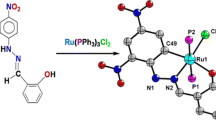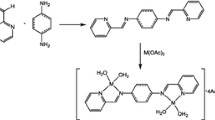Abstract
In this article, we explore the capacity of formed Schiff base complexes to trap metal atoms or ions, using their aromatic ends. The intrinsic geometry of each complex defines the process of substitution. Two cases were studied; one involving a trans Schiff base complex and the other considering how a salen ligand, with nickel systems traps chromium. We also assessed the nature of the new bonds and the frontier molecular orbitals.

Two salen nickel compounds are joint by a Cr(0) atom forming an organometallic interaction.














Similar content being viewed by others
References
Layer RW (1963) The chemistry of imines. Chem Rev 63:489–510
Al Zoubi W, Al-Hamdani AAS, Kaseem M (2016) Synthesis and antioxidant activities of Schiff bases and their complexes: a review. Appl Organomet Chem 30:810–817
Asif M (2015) An overview on synthesis and medicinal chemistry potentials of biologically active antimicrobial Schiff’s bases and its complexes: a review. Moroc J Chem 3:627–652
Ghosh S, Defrancq E (2010) Metal complex/DNA conjugates: a versatile building block for DNA nano-arrays. Chem Eur J 16:12780–12787
Garnowskii AD, Nivorozhkin AL, Minkin VI (1993) Ligand environment and the structure of Schiff base aducts and tetracoordinated metal-chelates. Coord Chem Rev 126:1–69
Hoser AA, Schilf W, Chelmieniecka AS, Kolodziej B, Kamienski B, Grech E, Wozniak K (2012) On the different coordination of Ni(II), Zn(II) and Cd(II) cations in their model Schiff base complexes- single crystal X-ray and solid state NMR studies. Polyhedron 31:241–248
Niemeyer J, Kehr G, Frölich R, Erker G (2008) Mastering the third dimension of salicylaldimine-type ligand systems: development of a convenient route to bis(“ferrocene-saliminato”)zirconium chemistry. Chem Eur J 14:9499–9502
Whiteoak CJ, Salassa G, Kleij AW (2012) Recent advances with π-conjugated salen systems. Chem Soc Rev 41:622–631
Mihan FY, Bartocci S, Brushini F, De Bernanrdin P, Forte G, Giannicci I, Dalla Cort A (2012) Ion pair recognition by metal-salophen and metal-salen complexes. Aus J Chem 65:1638–1646
Becke AD (1988) Density functional exchange energy approximation with correct asymptotic behavior. Phys Rev A 38:3098–3100
Perdew JP, Wang Y (1992) Accurate and simple analytic representation of the electron-gas correlation energy. Phys Rev B 45:13244–13249
Gaussian 09, Revision A.1, Frisch MJ, Trucks GW, Schlegel HB, Scuseria GE, Robb MA, Cheeseman JR, Scalmani G, Barone V, Mennucci B, Petersson GA, Nakatsuji H, Caricato M, Li X, Hratchian HP, Izmaylov AF, Bloino J, Zheng G, Sonnenberg JL, Hada M, Ehara M, Toyota K, Fukuda R, Hasegawa J, Ishida M, Nakajima T, Honda Y, Kitao O, Nakai H, Vreven T, Montgomery JA, Jr., Peralta JE, Ogliaro F, Bearpark M, Heyd JJ, Brothers E, Kudin KN, Staroverov VN, Kobayashi R, Normand J, Raghavachari K, Rendell A, Burant JC, Iyengar SS, Tomasi J, Cossi M, Rega N, Millam JM, Klene M, Knox JE, Cross JB, Bakken V, Adamo C, Jaramillo J, Gomperts R, Stratmann RE, Yazyev O, Austin AJ, Cammi R, Pomelli C, Ochterski JW, Martin RL, Morokuma K, Zakrzewski VG, Voth GA, Salvador P, Dannenberg JJ, Dapprich S, Daniels AD, Farkas Ö, Foresman JB, Ortiz JV, Cioslowski J, Fox DJ, Gaussian, Inc., Wallingford CT, 2009
Xiao H, Tahir-Kheli J, Goddard III WA (2011) Accurate band gaps for semiconductors from density functional theory. J Phys Chem Lett 2:210–217
Tolman CA (1972) The 16 and 18 electron rule in organometallic chemistry and homogeneous catalysis. Chem Soc Rev 1:337–353
Seyferth D (2002) Bis(benzene)chromium. 2. Its discovery by E. O. Fischer and W. Hafner and subsequent work by the research groups of E. O. Fischer, H. H. Zeiss, F. Hein, C. Elschenbroich, and others. Organometallics 21:2800–2820
Jiang J, Smith JR, Luo Y, Greenberg H, Ottosson H (2011) Multidecker bis(benzene)chromium: opportunities for design of rigid and highly flexible molecular wires. J Phys Chem C 115:785–790
Das NK, Shoji T (2012) Geometry, orbital interaction, and oxygen chemisorption properties of chromium doped nickel clusters. J Phys Chem C 116:13353–13367
Wiberg KB (1968) Application of the Pople-Santry-Segal CNDO method to the cyclopropyl carbonyl and cyclobutyl cation and to bicyclobutane. Tetrahedron 24:1083–1096
Kittel C (1986) Introduction to solid state physics, 6th edn. John Wiley, New York, p 185
Guo Z, Tong W-L, Chan MCW (2009) Axially rotating (PT-salphen)2 phosphorescent coordination frameworks. Chem Comm:6189–6191
Sun S, Tong W-L, Chan MCW (2010) Alternating poly(pt-salphen)-(p-phenyleneethynylene) as phosphorescent conjugated linear rod and coilable sensory material. Macromol Rapid Commun 31:1965–1969
Hardouin-Lerouge M, Hudhomme P, Sallé M (2011) Molecular clips and tweezers hosting neutral guests. Chem Soc Rev 40:30–43
Bensalem N, Zouchoune B (2016) Coordination capabilities of anthracene ligand in binuclear sandwich complexes: a DFT study. Struct Chem 27:1781–1792
Karabiyik H, Karabiyik H, Iskelei NO (2012) Hydrogen-bridged chelate ring-assisted π-stacking interactions. Acta Cryst B68:71–79
Acknowledgements
The authors would like to thank Alberto López, Cain González, Alejandro Pompa, and María Teresa Vázquez for their kind help, Oralia Espinoza for her technical assistance, and Caroline Karslake for English style correction. Many thanks also to DGAPA-UNAM for the grants corresponding to DGAPA PAPIIT IN203816 and RN203816 projects.
Author information
Authors and Affiliations
Corresponding author
Rights and permissions
About this article
Cite this article
Salcedo, R., Bosquez, M. Schiff base complexes that form sandwich compounds. J Mol Model 24, 72 (2018). https://doi.org/10.1007/s00894-018-3607-x
Received:
Accepted:
Published:
DOI: https://doi.org/10.1007/s00894-018-3607-x




